Analysis of Mahogany Harvesting Abolition, Incentives, and Homicide
VerifiedAdded on 2020/07/23
|20
|2955
|127
Report
AI Summary
This report examines the economic consequences of the Brazilian government's decision to abolish mahogany harvesting. It begins by analyzing the welfare effects of government interventions, such as taxation and quotas, on the mahogany market, illustrating the shifts in supply and demand curves and the resulting changes in equilibrium price and quantity. The report then delves into production decisions, exploring market structures like perfect competition and oligopoly, including collusion between major exporters. A significant portion of the report focuses on the impact of the harvesting ban on homicide rates, comparing homicide rates before and after the ban and analyzing the correlation between the illegalization of mahogany harvesting and the increase in violence. The analysis includes constructing graphs to illustrate the relationship between government intervention and the homicide rate. Finally, the report offers lessons and reflections on the unintended consequences of the ban, the theory of self-interest, and the concept of opportunity cost in the context of mahogany production, drawing conclusions about the effectiveness of the government's policies and their impact on both the economy and public safety.
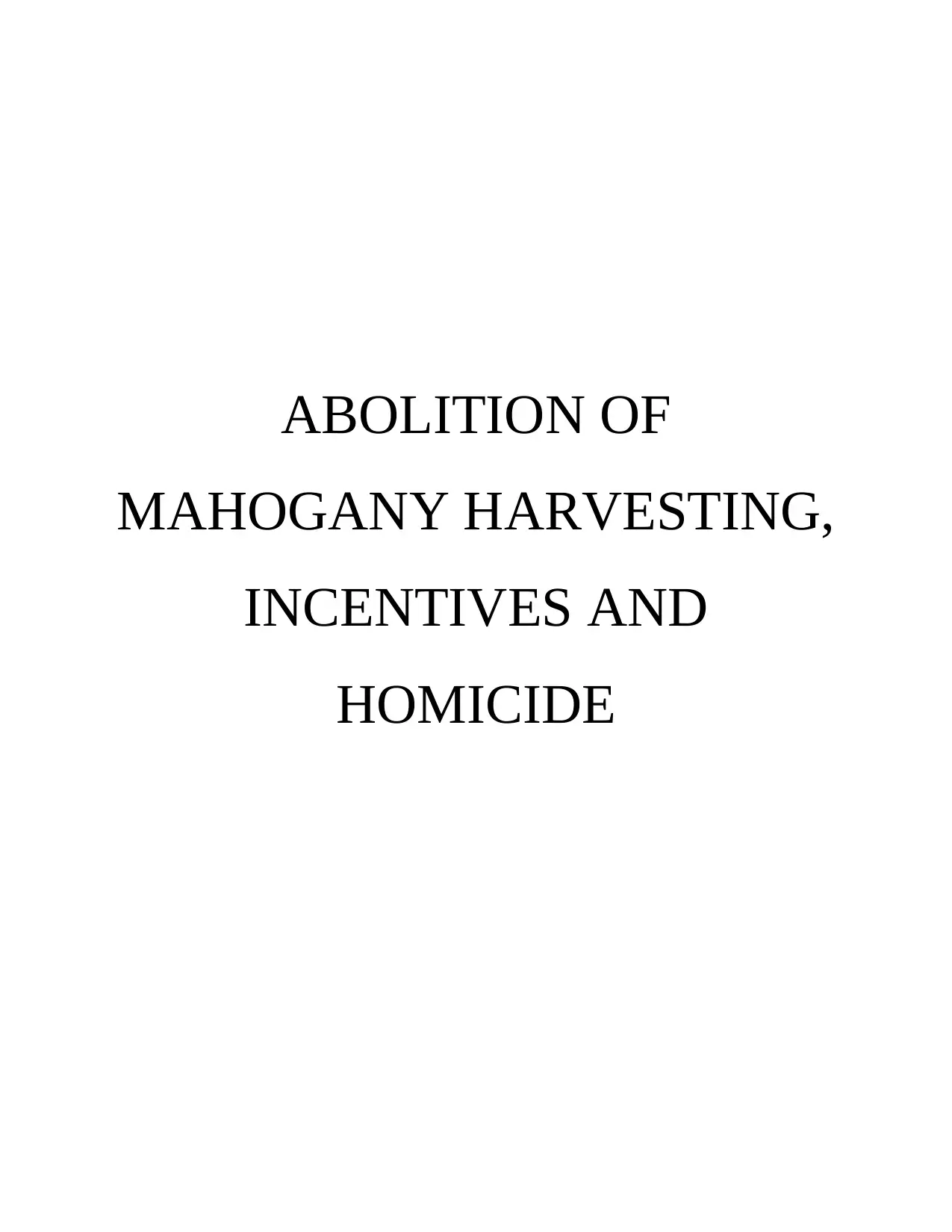
ABOLITION OF
MAHOGANY HARVESTING,
INCENTIVES AND
HOMICIDE
MAHOGANY HARVESTING,
INCENTIVES AND
HOMICIDE
Paraphrase This Document
Need a fresh take? Get an instant paraphrase of this document with our AI Paraphraser
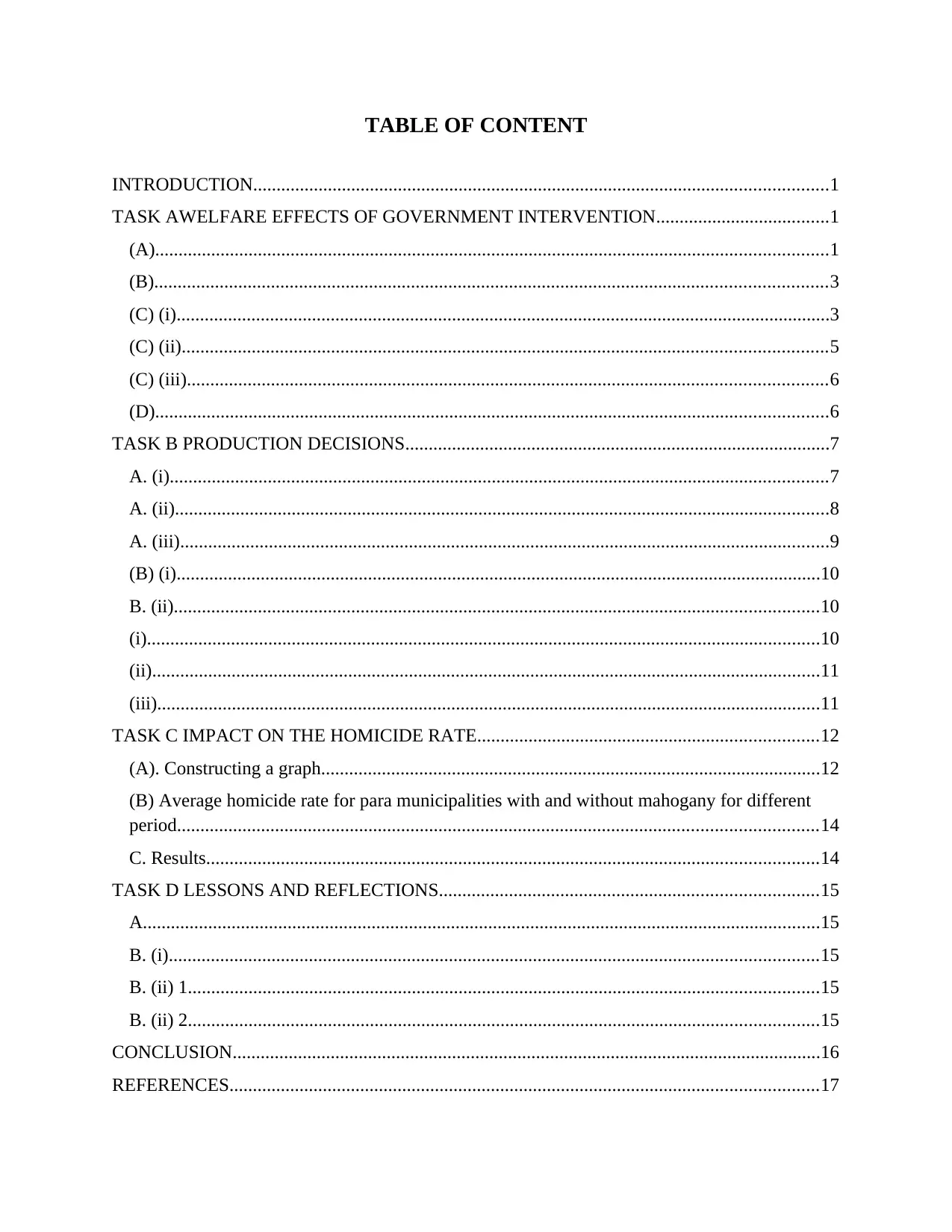
TABLE OF CONTENT
INTRODUCTION...........................................................................................................................1
TASK AWELFARE EFFECTS OF GOVERNMENT INTERVENTION.....................................1
(A)................................................................................................................................................1
(B)................................................................................................................................................3
(C) (i)............................................................................................................................................3
(C) (ii)..........................................................................................................................................5
(C) (iii).........................................................................................................................................6
(D)................................................................................................................................................6
TASK B PRODUCTION DECISIONS...........................................................................................7
A. (i).............................................................................................................................................7
A. (ii)............................................................................................................................................8
A. (iii)...........................................................................................................................................9
(B) (i)..........................................................................................................................................10
B. (ii)..........................................................................................................................................10
(i)................................................................................................................................................10
(ii)...............................................................................................................................................11
(iii)..............................................................................................................................................11
TASK C IMPACT ON THE HOMICIDE RATE.........................................................................12
(A). Constructing a graph...........................................................................................................12
(B) Average homicide rate for para municipalities with and without mahogany for different
period.........................................................................................................................................14
C. Results...................................................................................................................................14
TASK D LESSONS AND REFLECTIONS.................................................................................15
A.................................................................................................................................................15
B. (i)...........................................................................................................................................15
B. (ii) 1.......................................................................................................................................15
B. (ii) 2.......................................................................................................................................15
CONCLUSION..............................................................................................................................16
REFERENCES..............................................................................................................................17
INTRODUCTION...........................................................................................................................1
TASK AWELFARE EFFECTS OF GOVERNMENT INTERVENTION.....................................1
(A)................................................................................................................................................1
(B)................................................................................................................................................3
(C) (i)............................................................................................................................................3
(C) (ii)..........................................................................................................................................5
(C) (iii).........................................................................................................................................6
(D)................................................................................................................................................6
TASK B PRODUCTION DECISIONS...........................................................................................7
A. (i).............................................................................................................................................7
A. (ii)............................................................................................................................................8
A. (iii)...........................................................................................................................................9
(B) (i)..........................................................................................................................................10
B. (ii)..........................................................................................................................................10
(i)................................................................................................................................................10
(ii)...............................................................................................................................................11
(iii)..............................................................................................................................................11
TASK C IMPACT ON THE HOMICIDE RATE.........................................................................12
(A). Constructing a graph...........................................................................................................12
(B) Average homicide rate for para municipalities with and without mahogany for different
period.........................................................................................................................................14
C. Results...................................................................................................................................14
TASK D LESSONS AND REFLECTIONS.................................................................................15
A.................................................................................................................................................15
B. (i)...........................................................................................................................................15
B. (ii) 1.......................................................................................................................................15
B. (ii) 2.......................................................................................................................................15
CONCLUSION..............................................................................................................................16
REFERENCES..............................................................................................................................17
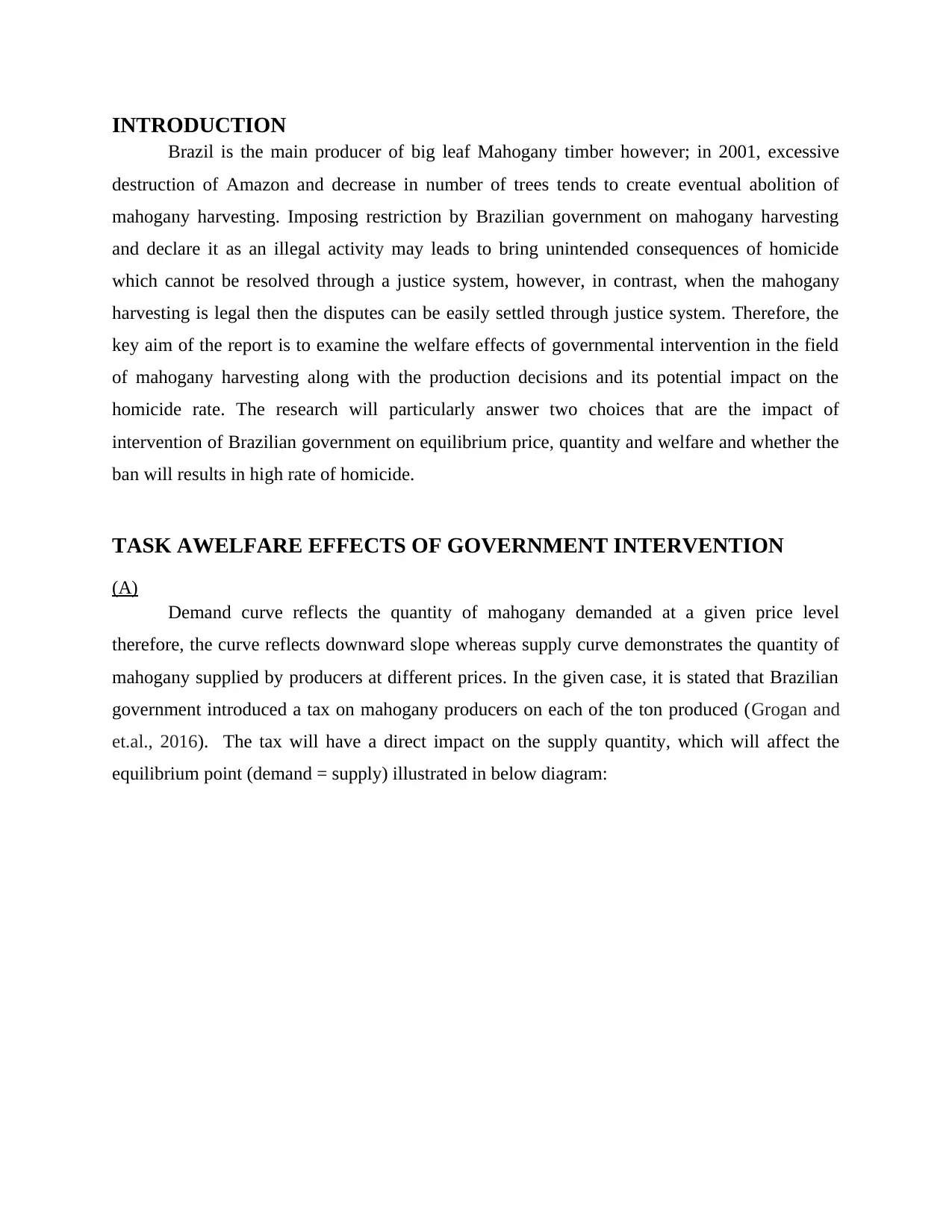
INTRODUCTION
Brazil is the main producer of big leaf Mahogany timber however; in 2001, excessive
destruction of Amazon and decrease in number of trees tends to create eventual abolition of
mahogany harvesting. Imposing restriction by Brazilian government on mahogany harvesting
and declare it as an illegal activity may leads to bring unintended consequences of homicide
which cannot be resolved through a justice system, however, in contrast, when the mahogany
harvesting is legal then the disputes can be easily settled through justice system. Therefore, the
key aim of the report is to examine the welfare effects of governmental intervention in the field
of mahogany harvesting along with the production decisions and its potential impact on the
homicide rate. The research will particularly answer two choices that are the impact of
intervention of Brazilian government on equilibrium price, quantity and welfare and whether the
ban will results in high rate of homicide.
TASK AWELFARE EFFECTS OF GOVERNMENT INTERVENTION
(A)
Demand curve reflects the quantity of mahogany demanded at a given price level
therefore, the curve reflects downward slope whereas supply curve demonstrates the quantity of
mahogany supplied by producers at different prices. In the given case, it is stated that Brazilian
government introduced a tax on mahogany producers on each of the ton produced (Grogan and
et.al., 2016). The tax will have a direct impact on the supply quantity, which will affect the
equilibrium point (demand = supply) illustrated in below diagram:
Brazil is the main producer of big leaf Mahogany timber however; in 2001, excessive
destruction of Amazon and decrease in number of trees tends to create eventual abolition of
mahogany harvesting. Imposing restriction by Brazilian government on mahogany harvesting
and declare it as an illegal activity may leads to bring unintended consequences of homicide
which cannot be resolved through a justice system, however, in contrast, when the mahogany
harvesting is legal then the disputes can be easily settled through justice system. Therefore, the
key aim of the report is to examine the welfare effects of governmental intervention in the field
of mahogany harvesting along with the production decisions and its potential impact on the
homicide rate. The research will particularly answer two choices that are the impact of
intervention of Brazilian government on equilibrium price, quantity and welfare and whether the
ban will results in high rate of homicide.
TASK AWELFARE EFFECTS OF GOVERNMENT INTERVENTION
(A)
Demand curve reflects the quantity of mahogany demanded at a given price level
therefore, the curve reflects downward slope whereas supply curve demonstrates the quantity of
mahogany supplied by producers at different prices. In the given case, it is stated that Brazilian
government introduced a tax on mahogany producers on each of the ton produced (Grogan and
et.al., 2016). The tax will have a direct impact on the supply quantity, which will affect the
equilibrium point (demand = supply) illustrated in below diagram:
⊘ This is a preview!⊘
Do you want full access?
Subscribe today to unlock all pages.

Trusted by 1+ million students worldwide
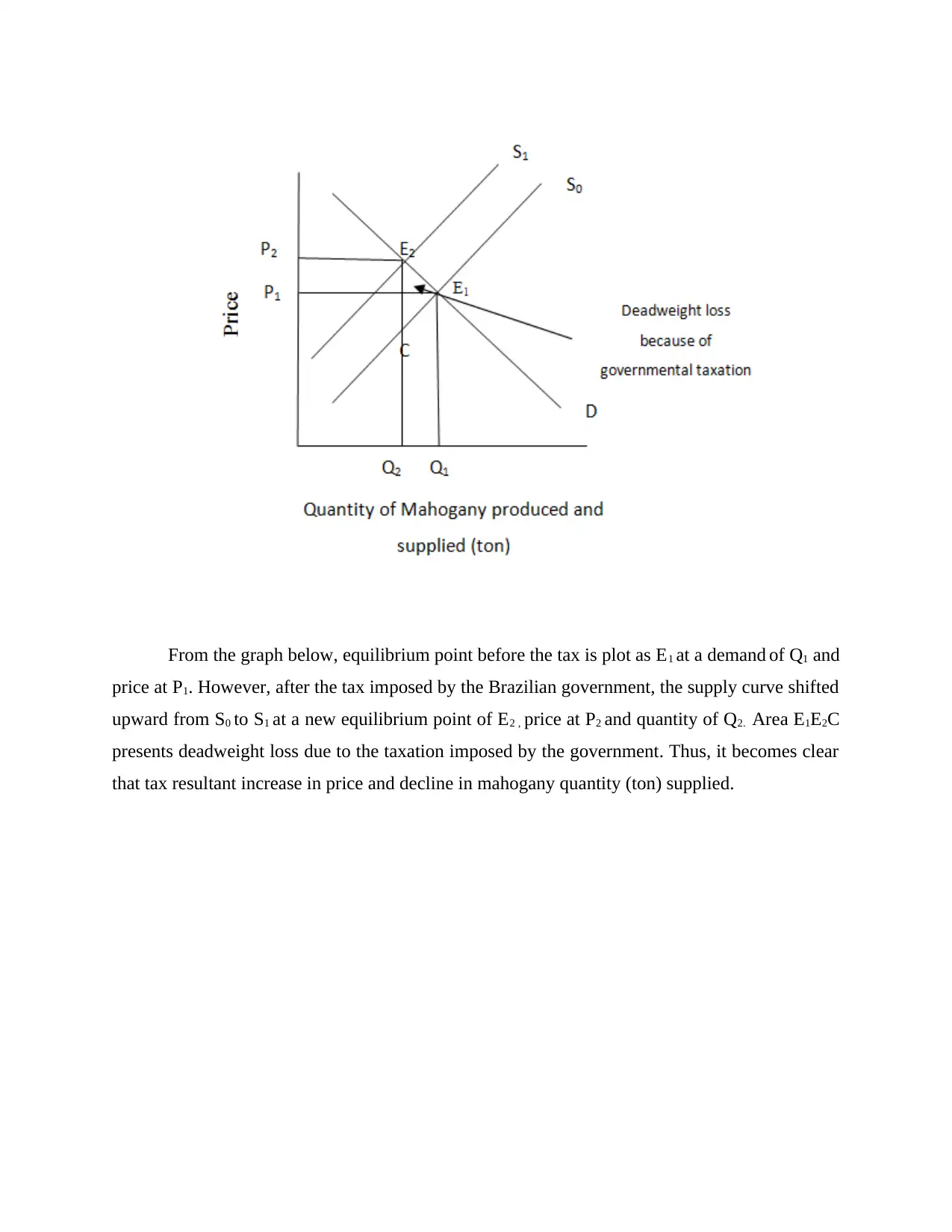
From the graph below, equilibrium point before the tax is plot as E1 at a demand of Q1 and
price at P1. However, after the tax imposed by the Brazilian government, the supply curve shifted
upward from S0 to S1 at a new equilibrium point of E2 , price at P2 and quantity of Q2. Area E1E2C
presents deadweight loss due to the taxation imposed by the government. Thus, it becomes clear
that tax resultant increase in price and decline in mahogany quantity (ton) supplied.
price at P1. However, after the tax imposed by the Brazilian government, the supply curve shifted
upward from S0 to S1 at a new equilibrium point of E2 , price at P2 and quantity of Q2. Area E1E2C
presents deadweight loss due to the taxation imposed by the government. Thus, it becomes clear
that tax resultant increase in price and decline in mahogany quantity (ton) supplied.
Paraphrase This Document
Need a fresh take? Get an instant paraphrase of this document with our AI Paraphraser
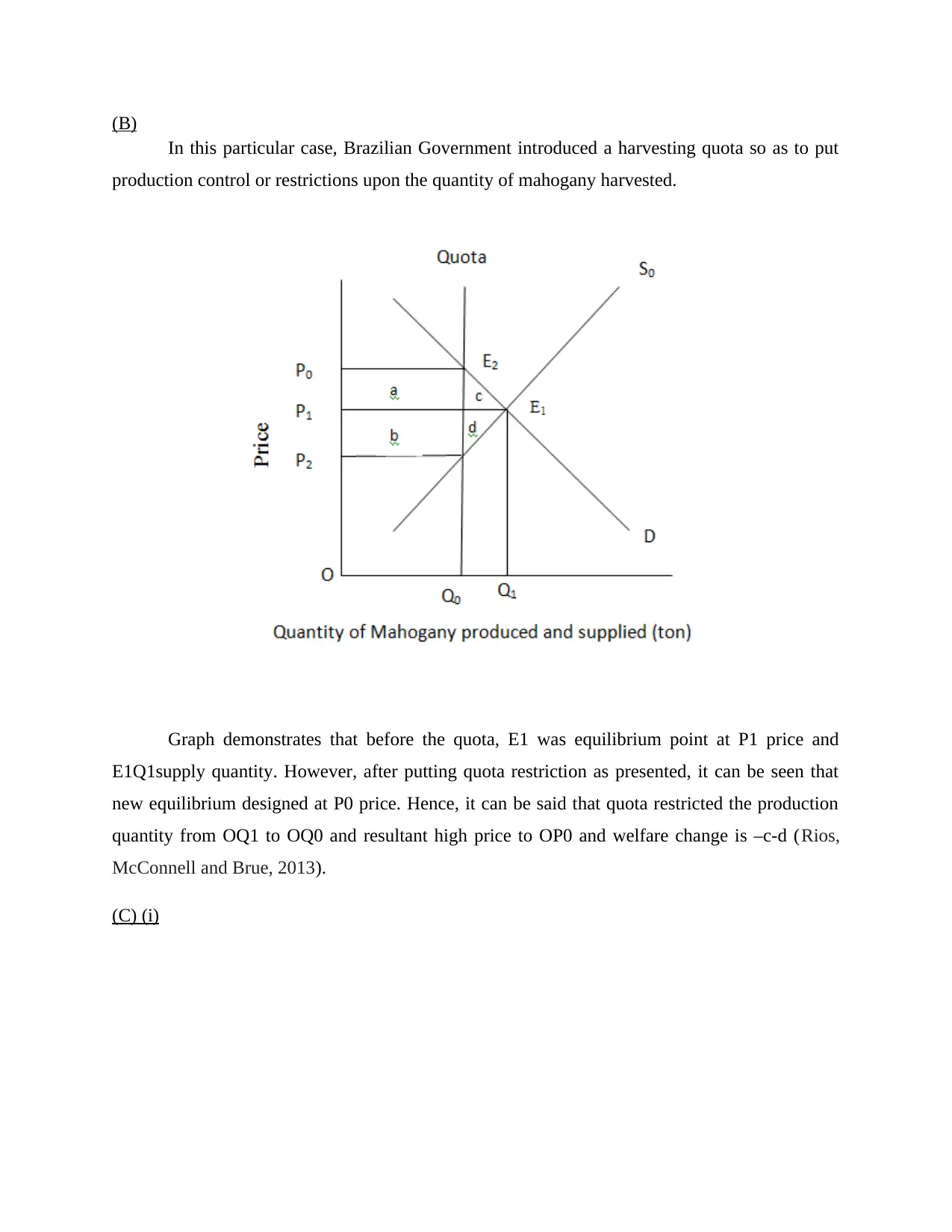
(B)
In this particular case, Brazilian Government introduced a harvesting quota so as to put
production control or restrictions upon the quantity of mahogany harvested.
Graph demonstrates that before the quota, E1 was equilibrium point at P1 price and
E1Q1supply quantity. However, after putting quota restriction as presented, it can be seen that
new equilibrium designed at P0 price. Hence, it can be said that quota restricted the production
quantity from OQ1 to OQ0 and resultant high price to OP0 and welfare change is –c-d (Rios,
McConnell and Brue, 2013).
(C) (i)
In this particular case, Brazilian Government introduced a harvesting quota so as to put
production control or restrictions upon the quantity of mahogany harvested.
Graph demonstrates that before the quota, E1 was equilibrium point at P1 price and
E1Q1supply quantity. However, after putting quota restriction as presented, it can be seen that
new equilibrium designed at P0 price. Hence, it can be said that quota restricted the production
quantity from OQ1 to OQ0 and resultant high price to OP0 and welfare change is –c-d (Rios,
McConnell and Brue, 2013).
(C) (i)
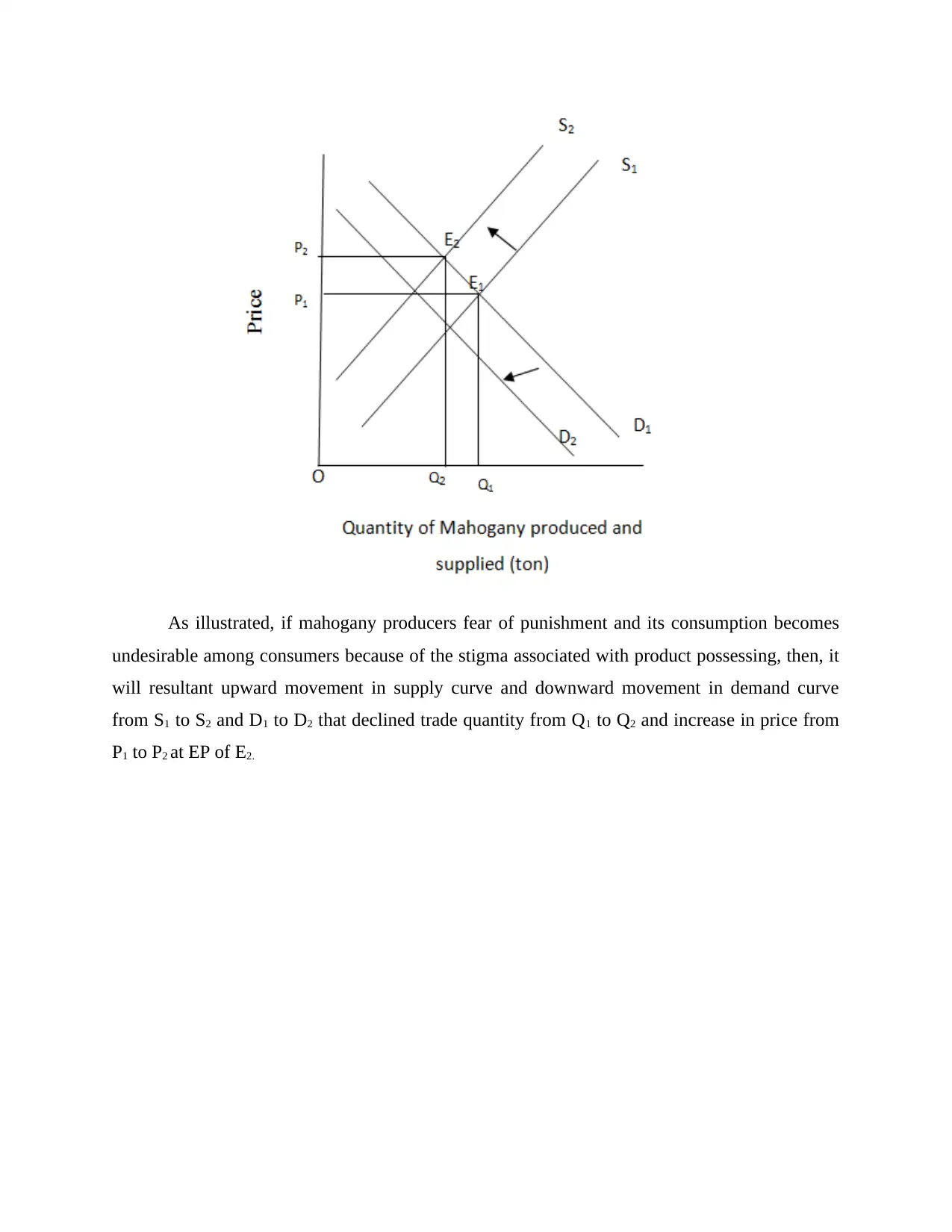
As illustrated, if mahogany producers fear of punishment and its consumption becomes
undesirable among consumers because of the stigma associated with product possessing, then, it
will resultant upward movement in supply curve and downward movement in demand curve
from S1 to S2 and D1 to D2 that declined trade quantity from Q1 to Q2 and increase in price from
P1 to P2 at EP of E2.
undesirable among consumers because of the stigma associated with product possessing, then, it
will resultant upward movement in supply curve and downward movement in demand curve
from S1 to S2 and D1 to D2 that declined trade quantity from Q1 to Q2 and increase in price from
P1 to P2 at EP of E2.
⊘ This is a preview!⊘
Do you want full access?
Subscribe today to unlock all pages.

Trusted by 1+ million students worldwide
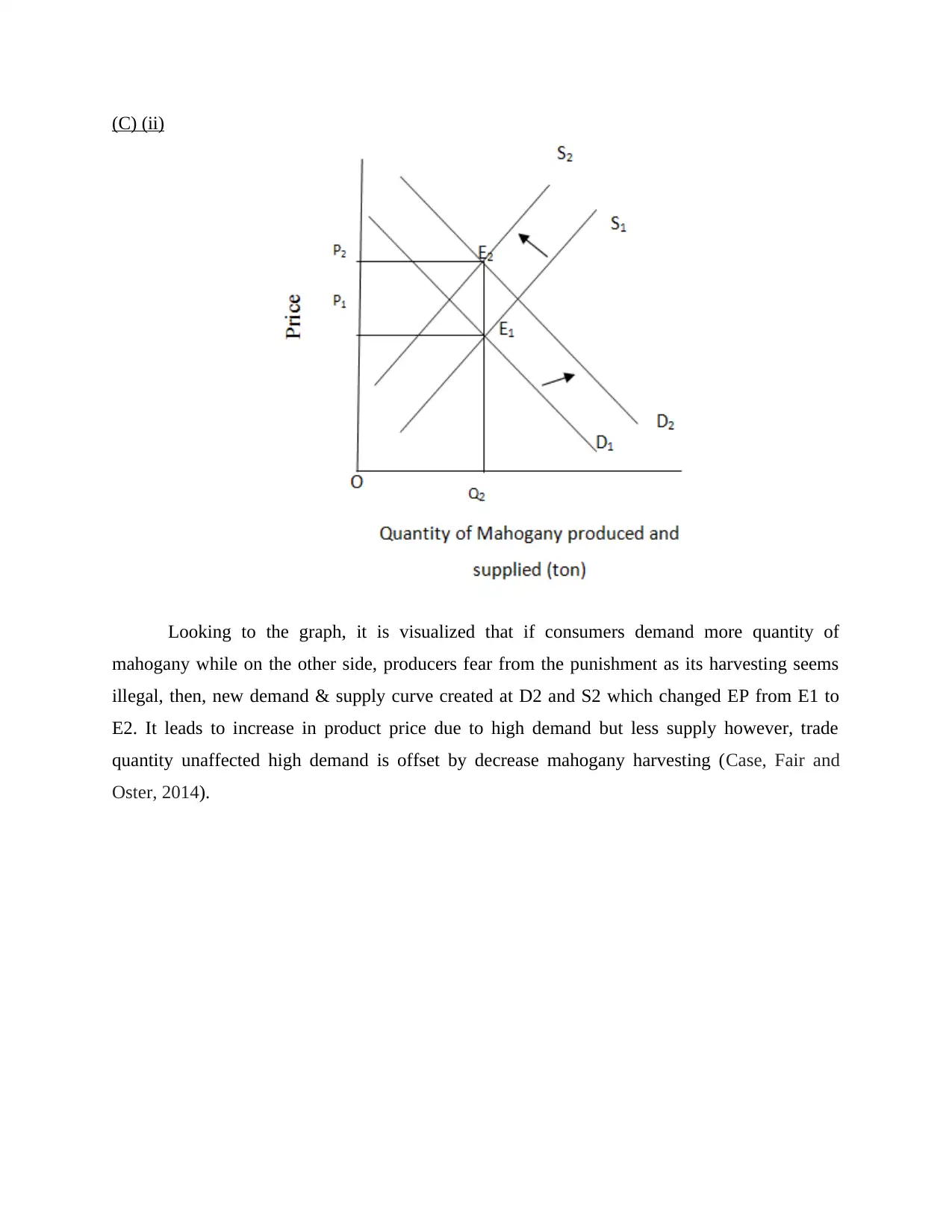
(C) (ii)
Looking to the graph, it is visualized that if consumers demand more quantity of
mahogany while on the other side, producers fear from the punishment as its harvesting seems
illegal, then, new demand & supply curve created at D2 and S2 which changed EP from E1 to
E2. It leads to increase in product price due to high demand but less supply however, trade
quantity unaffected high demand is offset by decrease mahogany harvesting (Case, Fair and
Oster, 2014).
Looking to the graph, it is visualized that if consumers demand more quantity of
mahogany while on the other side, producers fear from the punishment as its harvesting seems
illegal, then, new demand & supply curve created at D2 and S2 which changed EP from E1 to
E2. It leads to increase in product price due to high demand but less supply however, trade
quantity unaffected high demand is offset by decrease mahogany harvesting (Case, Fair and
Oster, 2014).
Paraphrase This Document
Need a fresh take? Get an instant paraphrase of this document with our AI Paraphraser
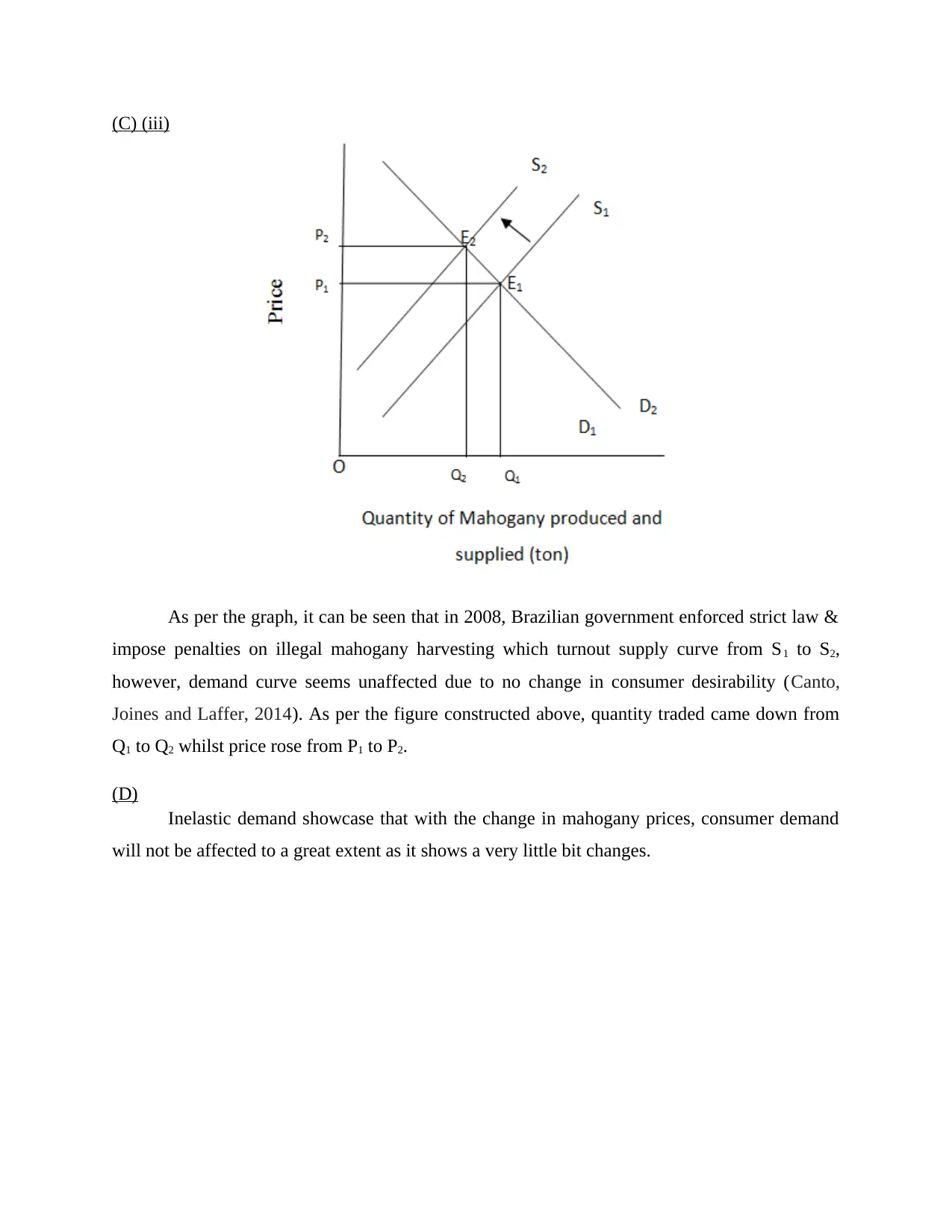
(C) (iii)
As per the graph, it can be seen that in 2008, Brazilian government enforced strict law &
impose penalties on illegal mahogany harvesting which turnout supply curve from S1 to S2,
however, demand curve seems unaffected due to no change in consumer desirability (Canto,
Joines and Laffer, 2014). As per the figure constructed above, quantity traded came down from
Q1 to Q2 whilst price rose from P1 to P2.
(D)
Inelastic demand showcase that with the change in mahogany prices, consumer demand
will not be affected to a great extent as it shows a very little bit changes.
As per the graph, it can be seen that in 2008, Brazilian government enforced strict law &
impose penalties on illegal mahogany harvesting which turnout supply curve from S1 to S2,
however, demand curve seems unaffected due to no change in consumer desirability (Canto,
Joines and Laffer, 2014). As per the figure constructed above, quantity traded came down from
Q1 to Q2 whilst price rose from P1 to P2.
(D)
Inelastic demand showcase that with the change in mahogany prices, consumer demand
will not be affected to a great extent as it shows a very little bit changes.

Above graph presents inelastic demand curve titled as D, before the tax imputation,
supply curve was S1 whereas after the tax, it moved upward to S2 reached to new EP to E2. In the
graph, government taxation on mahogany resulted high increase in price from P1 to P2
represented by area “a” however, demand shows a little bit decrease from OQ1 to OQ2. This is
the logical reason why economist advices the government to reduce demand.
TASK B PRODUCTION DECISIONS
A. (i)
As the scenario presents that there are numerous competitors with no entry & exit barriers
for mahogany production, it present the market characteristics of perfect competition. Profit
maximization is the result of excess of revenue over cost.
supply curve was S1 whereas after the tax, it moved upward to S2 reached to new EP to E2. In the
graph, government taxation on mahogany resulted high increase in price from P1 to P2
represented by area “a” however, demand shows a little bit decrease from OQ1 to OQ2. This is
the logical reason why economist advices the government to reduce demand.
TASK B PRODUCTION DECISIONS
A. (i)
As the scenario presents that there are numerous competitors with no entry & exit barriers
for mahogany production, it present the market characteristics of perfect competition. Profit
maximization is the result of excess of revenue over cost.
⊘ This is a preview!⊘
Do you want full access?
Subscribe today to unlock all pages.

Trusted by 1+ million students worldwide
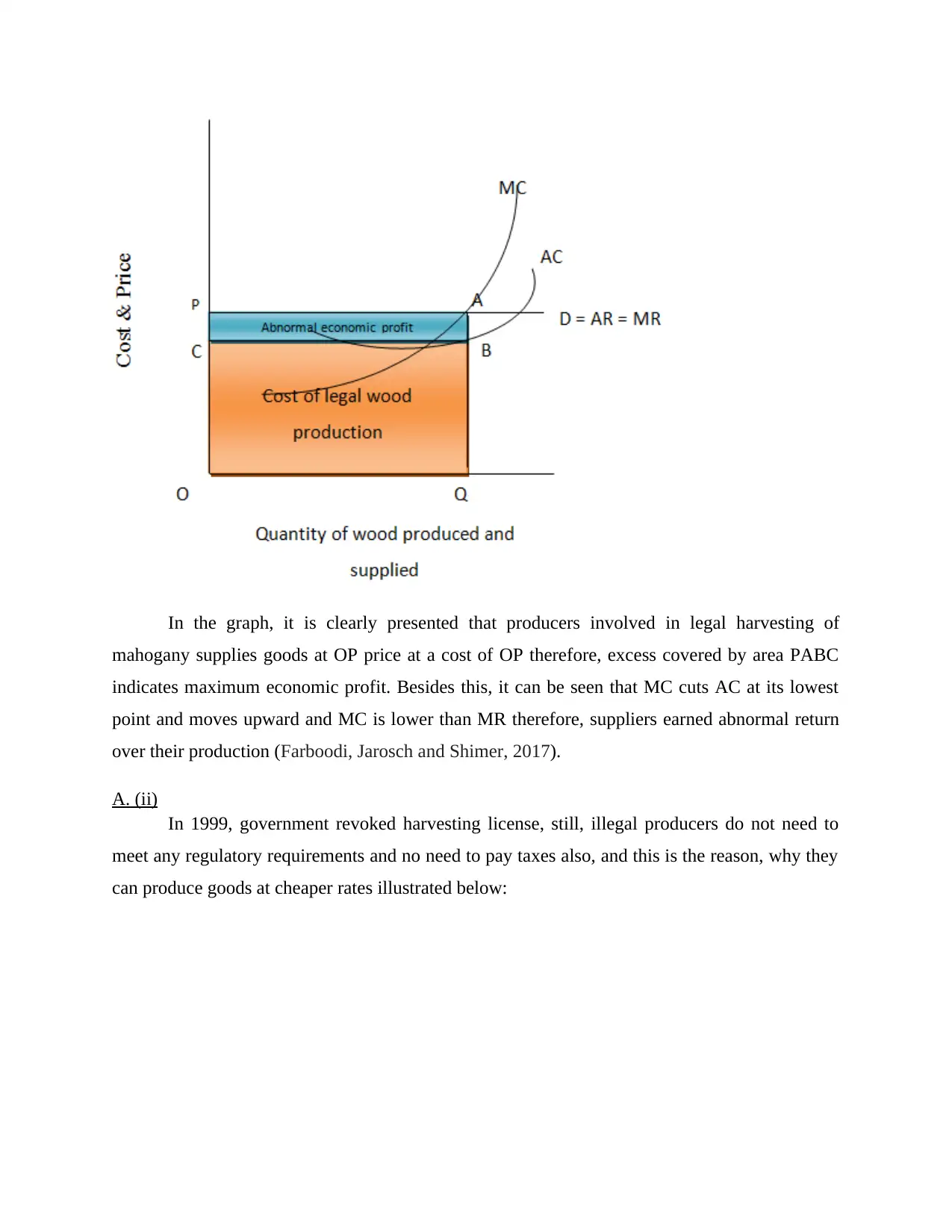
In the graph, it is clearly presented that producers involved in legal harvesting of
mahogany supplies goods at OP price at a cost of OP therefore, excess covered by area PABC
indicates maximum economic profit. Besides this, it can be seen that MC cuts AC at its lowest
point and moves upward and MC is lower than MR therefore, suppliers earned abnormal return
over their production (Farboodi, Jarosch and Shimer, 2017).
A. (ii)
In 1999, government revoked harvesting license, still, illegal producers do not need to
meet any regulatory requirements and no need to pay taxes also, and this is the reason, why they
can produce goods at cheaper rates illustrated below:
mahogany supplies goods at OP price at a cost of OP therefore, excess covered by area PABC
indicates maximum economic profit. Besides this, it can be seen that MC cuts AC at its lowest
point and moves upward and MC is lower than MR therefore, suppliers earned abnormal return
over their production (Farboodi, Jarosch and Shimer, 2017).
A. (ii)
In 1999, government revoked harvesting license, still, illegal producers do not need to
meet any regulatory requirements and no need to pay taxes also, and this is the reason, why they
can produce goods at cheaper rates illustrated below:
Paraphrase This Document
Need a fresh take? Get an instant paraphrase of this document with our AI Paraphraser
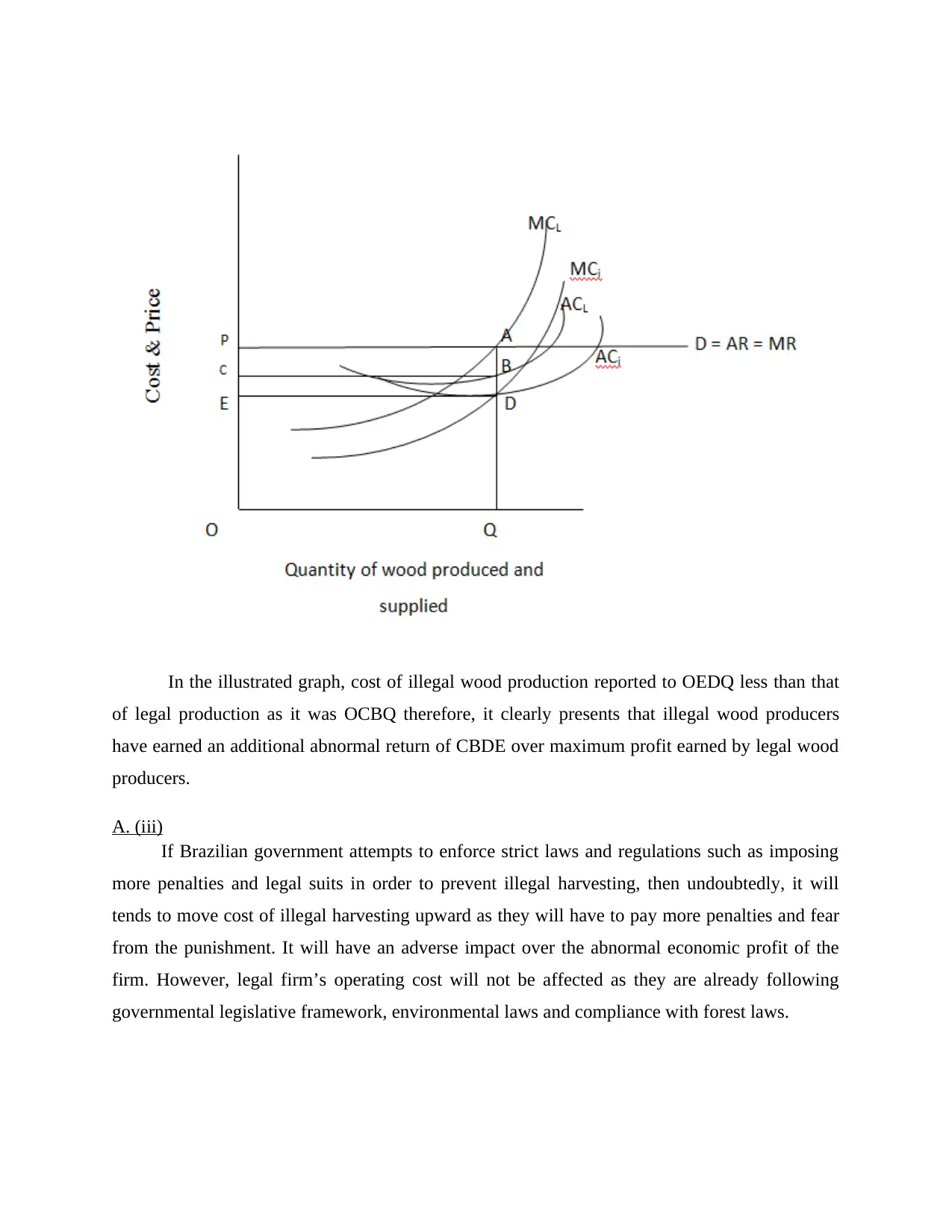
In the illustrated graph, cost of illegal wood production reported to OEDQ less than that
of legal production as it was OCBQ therefore, it clearly presents that illegal wood producers
have earned an additional abnormal return of CBDE over maximum profit earned by legal wood
producers.
A. (iii)
If Brazilian government attempts to enforce strict laws and regulations such as imposing
more penalties and legal suits in order to prevent illegal harvesting, then undoubtedly, it will
tends to move cost of illegal harvesting upward as they will have to pay more penalties and fear
from the punishment. It will have an adverse impact over the abnormal economic profit of the
firm. However, legal firm’s operating cost will not be affected as they are already following
governmental legislative framework, environmental laws and compliance with forest laws.
of legal production as it was OCBQ therefore, it clearly presents that illegal wood producers
have earned an additional abnormal return of CBDE over maximum profit earned by legal wood
producers.
A. (iii)
If Brazilian government attempts to enforce strict laws and regulations such as imposing
more penalties and legal suits in order to prevent illegal harvesting, then undoubtedly, it will
tends to move cost of illegal harvesting upward as they will have to pay more penalties and fear
from the punishment. It will have an adverse impact over the abnormal economic profit of the
firm. However, legal firm’s operating cost will not be affected as they are already following
governmental legislative framework, environmental laws and compliance with forest laws.
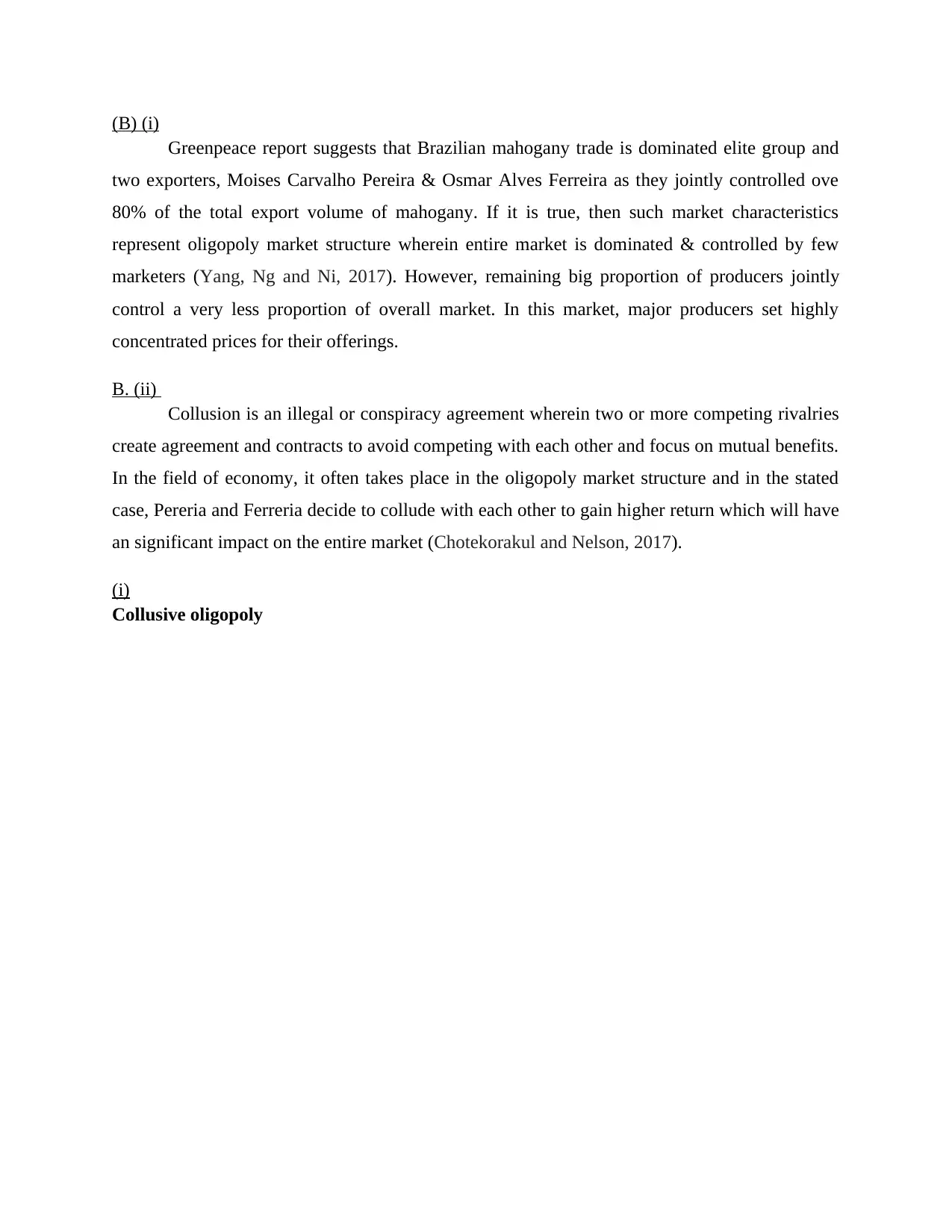
(B) (i)
Greenpeace report suggests that Brazilian mahogany trade is dominated elite group and
two exporters, Moises Carvalho Pereira & Osmar Alves Ferreira as they jointly controlled ove
80% of the total export volume of mahogany. If it is true, then such market characteristics
represent oligopoly market structure wherein entire market is dominated & controlled by few
marketers (Yang, Ng and Ni, 2017). However, remaining big proportion of producers jointly
control a very less proportion of overall market. In this market, major producers set highly
concentrated prices for their offerings.
B. (ii)
Collusion is an illegal or conspiracy agreement wherein two or more competing rivalries
create agreement and contracts to avoid competing with each other and focus on mutual benefits.
In the field of economy, it often takes place in the oligopoly market structure and in the stated
case, Pereria and Ferreria decide to collude with each other to gain higher return which will have
an significant impact on the entire market (Chotekorakul and Nelson, 2017).
(i)
Collusive oligopoly
Greenpeace report suggests that Brazilian mahogany trade is dominated elite group and
two exporters, Moises Carvalho Pereira & Osmar Alves Ferreira as they jointly controlled ove
80% of the total export volume of mahogany. If it is true, then such market characteristics
represent oligopoly market structure wherein entire market is dominated & controlled by few
marketers (Yang, Ng and Ni, 2017). However, remaining big proportion of producers jointly
control a very less proportion of overall market. In this market, major producers set highly
concentrated prices for their offerings.
B. (ii)
Collusion is an illegal or conspiracy agreement wherein two or more competing rivalries
create agreement and contracts to avoid competing with each other and focus on mutual benefits.
In the field of economy, it often takes place in the oligopoly market structure and in the stated
case, Pereria and Ferreria decide to collude with each other to gain higher return which will have
an significant impact on the entire market (Chotekorakul and Nelson, 2017).
(i)
Collusive oligopoly
⊘ This is a preview!⊘
Do you want full access?
Subscribe today to unlock all pages.

Trusted by 1+ million students worldwide
1 out of 20
Related Documents
Your All-in-One AI-Powered Toolkit for Academic Success.
+13062052269
info@desklib.com
Available 24*7 on WhatsApp / Email
![[object Object]](/_next/static/media/star-bottom.7253800d.svg)
Unlock your academic potential
Copyright © 2020–2025 A2Z Services. All Rights Reserved. Developed and managed by ZUCOL.





